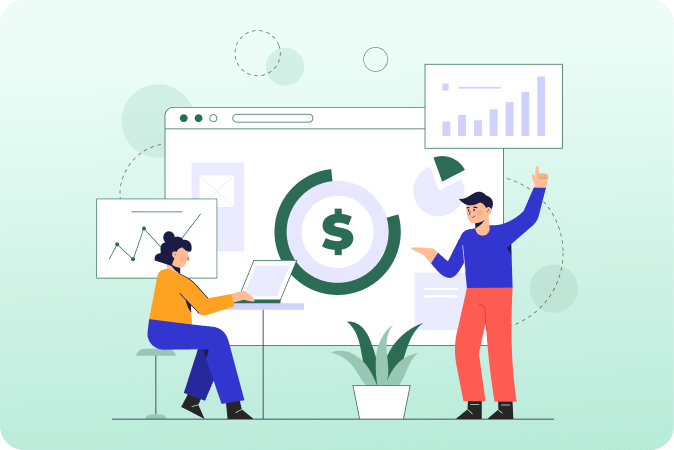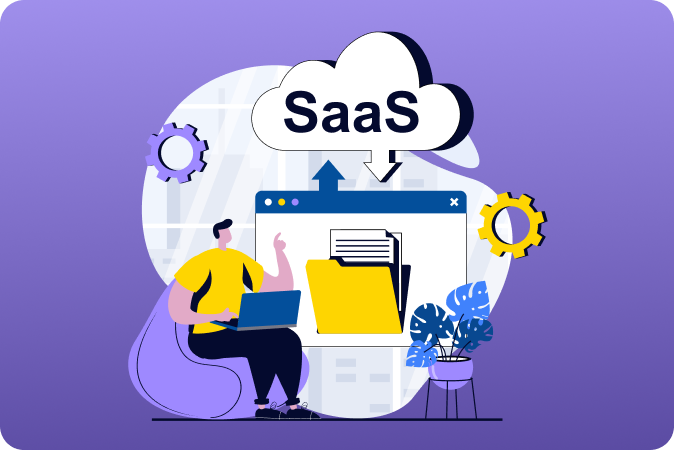
SaaS or Software as a Service (SaaS) represents a cloud-based delivery solution/platform where applications are hosted online. These platforms/tools can be accessed via the internet, eliminating the need for local installation or ongoing maintenance.
This SaaS guide explains what SaaS is, how it works, and why it has become the backbone of modern business operations and productivity tools.
What Is SaaS & Why Is It Becoming Popular In 2025?
As mentioned before, SaaS modules are hosted in cloud servers managed by service providers. The three main components that define SaaS models include:
- Processing power, storage, and maintenance occur on remote servers
- Users access this software through browsers or dedicated apps, using an internet connection.
- A subscription-based pricing model allows businesses to pay for what they use.
The SaaS model has eliminated the need for:
- Expensive hardware installations,
- Complex IT maintenance, and
- Hefty upfront licensing fees.
This shared module enables small businesses to access the powerful tools at a fraction of traditional software costs.
How SaaS Works: A Step-by-Step Breakdown
There is a step-by-step overview of how SaaS works:
- Cloud Infrastructure Setup: Applications are hosted on secure cloud servers. The best software providers ensure 99.9% uptime and data protection.
- Internet-Based Access: Users connect to applications through browsers or apps. No local software installations or complex IT configurations.
- Subscription Management: Most developers offer different pricing tiers based on features and usage requirements. You can go for a pricing model that suits your current requirements and can upgrade to higher models when needed.
- Automatic Updates: You don’t need to think about software, functionality, or security updates. All these elements are taken care of by the software providers. Users always access the latest version.
- Data Synchronization: All user devices get real-time synchronization so that your teams can collaborate and you will have uninterrupted data access from any location.
Popular SaaS Examples Transforming Business Operations
Popular SaaS products in 2025 include the following:
Business Productivity & Collaboration:
- Google Workspace and Microsoft 365 for document creation, email, and team collaboration
- Zoom and Microsoft Teams for video conferencing and virtual meetings
- E-connect for instant messaging and workflow integration
Project Management & Task Organization:
- Asana and Monday.com for team project coordination
- TaskHub by WeekMate is offering lifetime access without per-user charges
- Trello for visual project tracking and team collaboration
Customer Relationship & Human Resources:
- Salesforce and HubSpot for customer relationship management
- WeekMate HRMS provides comprehensive HR automation with one-time licensing
- E-CRM solutions for sales pipeline management and customer data organization
Specialized Business Tools:
- Shopify and BigCommerce for e-commerce platforms
- Email Marketing Tools for automated customer communication
- Estimation Tools for accurate project pricing and proposal generation
Education & Assessment:
- Canvas and Blackboard for learning management
- Exam Toolkit solutions for secure online testing and assessment
Key Advantages of SaaS Solutions
Benefits of SaaS in cloud computing include:
- Cost-Effective: No need to purchase expensive hardware or licenses. Pay only for what you use.
- Scalable: Add or remove SaaS users as your business grows.
- Accessible Anywhere: Access the tool from any location with an internet connection.
- Automatic Updates: Get the most recent features and security patches without any manual intervention.
- Low Maintenance: The provider handles uptime, backups, and performance monitoring.
What Are The SaaS Limitations?
| Challenge | Smart Solution & Benefit |
| No Internet = No Work | Use mobile hotspots + choose tools with offline sync |
| Limited Offline Features | Pick SaaS with strong offline modes & work anywhere, anytime. |
| Data Security Worries | Select certified providers (SOC 2, GDPR compliant) |
| Switching Costs High | Choose tools with easy data export and lifetime licensing |
| Can’t Customize Enough | Use flexible platforms with APIs and integration capabilities. |
| Monthly Bills Add Up | Go with one-time license models like WeekMate. |
The Future of SaaS in 2025 and Beyond
As a business, when you implement our SaaS solutions, you get impressive benefits like operational agility and a competitive edge in today’s evolving digital marketplace.
Invest in sustainable growth and operational efficiency with Weekmate SaaS products
Book a free demo session
FAQs
What is SaaS in simple words?
SaaS (Software as a Service) is software that you access through the internet instead of installing on your computer.
How does SaaS work for small businesses?
Small businesses can start with SaaS tools like WeekMate HRMS for a fraction of that cost. Plus, you don’t need a full IT team. The software provider handles all the technical stuff.
What are the 3 best SaaS examples for startups in 2025?
For a business just getting started, focus on these:
Get organized with project management tools like TaskHub to keep your team on track.
Manage your customers with CRM tools like E-CRM to turn leads into sales.
Keep everyone connected with communication tools like E-Connect.
What is the difference between SaaS platform and traditional software?
When using traditional software, you’re responsible for all maintenance and updates. With SaaS, you get the latest features automatically. With traditional software, if your computer crashes, you lose everything. With SaaS, your data is safely stored in the cloud.



